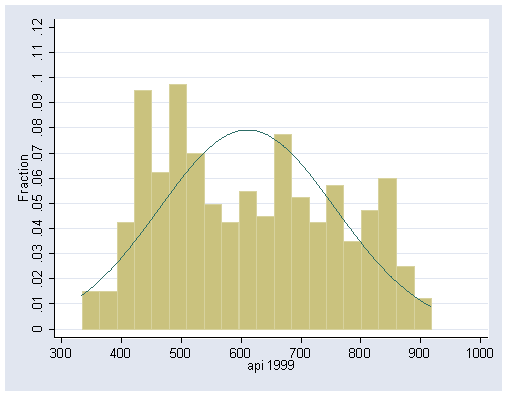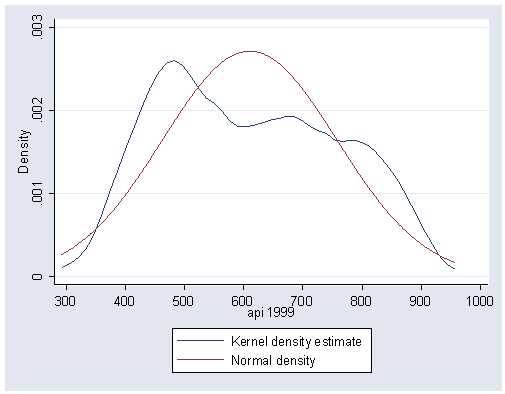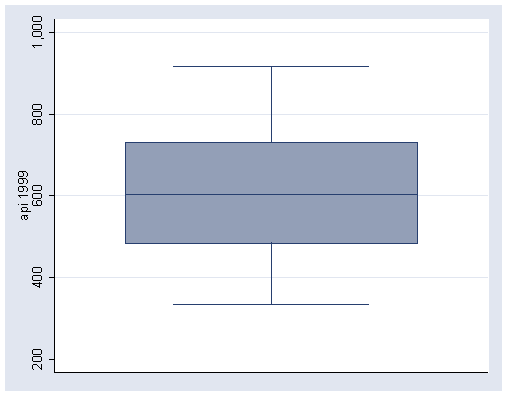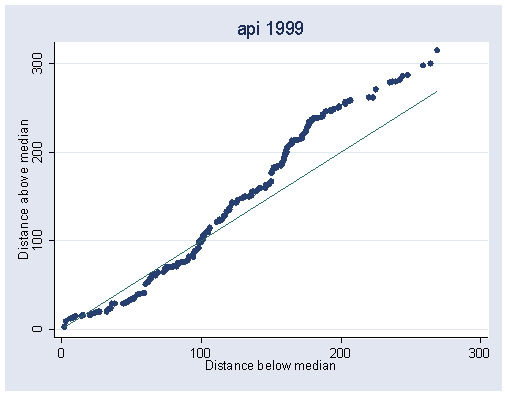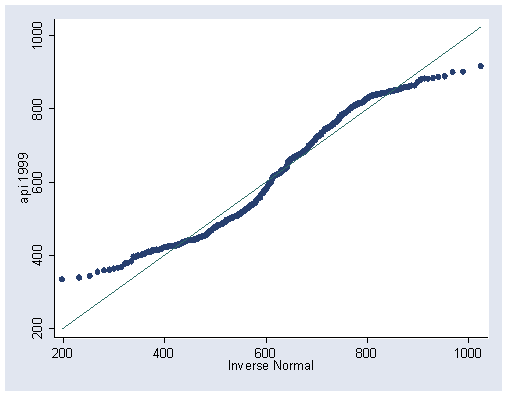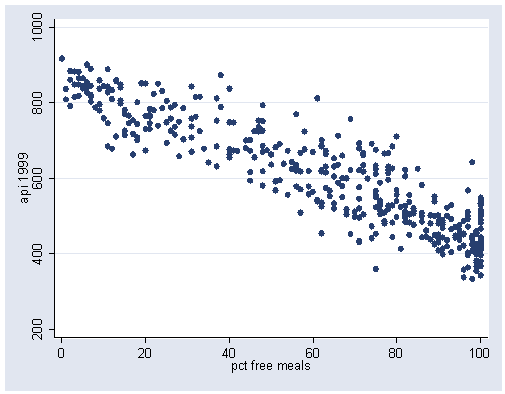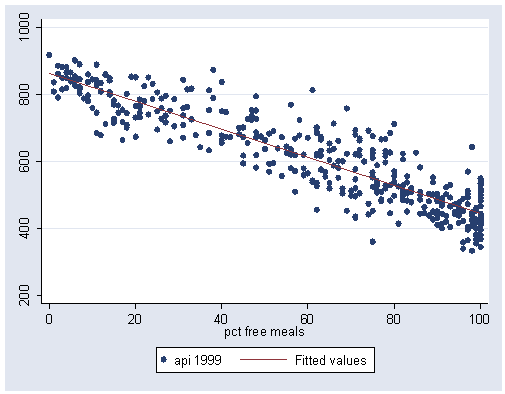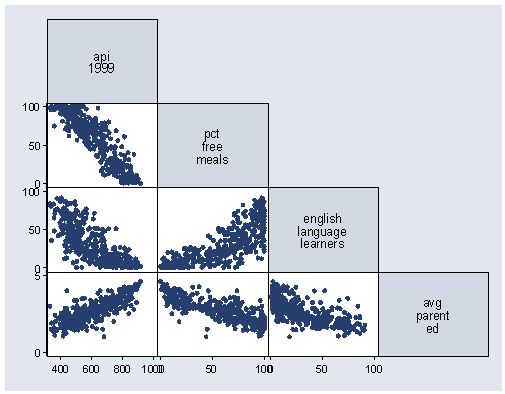Question 1.
Make five graphs of api99: histogram, kdensity plot, boxplot, symmetry plot and normal
quantile plot.
Answer 1.
First we use the elemapi2 data file.
use https://stats.idre.ucla.edu/stat/stata/webbooks/reg/elemapi2, clear
Below we make the plots mentioned in question 1.
Histogram
histogram api99, bin(20) fraction normal xlabel(300(100)1000) ylabel(0(.01).12)
kdensity plot
kdensity api99, normal xlabel(300(100)1000)
boxplot
graph box api99
symmetry plot
symplot api99
normal quantile plot
qnorm api99
Question 2.
What is the correlation between api99 and meals?
Answer 2.
Below we use the corr command to get this correlation.
corr api99 meals
(obs=400)
| api99 meals
-------------+------------------
api99 | 1.0000
meals | -0.9081 1.0000
Question 3.
Regress api99 on meals. What does the output tell you?
Answer 3.
Below we perform the regression predicting api99 from meals.
regress api99 meals
Source | SS df MS Number of obs = 400
-------------+------------------------------ F( 1, 398) = 1872.39
Model | 7123743.65 1 7123743.65 Prob > F = 0.0000
Residual | 1514239.28 398 3804.62132 R-squared = 0.8247
-------------+------------------------------ Adj R-squared = 0.8243
Total | 8637982.94 399 21649.08 Root MSE = 61.682
------------------------------------------------------------------------------
api99 | Coef. Std. Err. t P>|t| [95% Conf. Interval]
-------------+----------------------------------------------------------------
meals | -4.187142 .0967652 -43.27 0.000 -4.377377 -3.996908
_cons | 862.76 6.60114 130.70 0.000 849.7825 875.7375
------------------------------------------------------------------------------
We see that the coefficient for meals has a t value of -43 and that it is significant. The coefficient is -4.18 (let’s round it to -4.2) so very every unit increase in meals, api99 goes down by 4.22 points. In other words, for every percent increase in children who receive free meals in a school, the api score for that school would be predicted to decrease by 4.2 points.
Question 4.
Create and list the fitted (predicted) values.
Answer 4.
We can create the predicted values using the predict command, as shown below.
predict yhat
(option xb assumed; fitted values)
We can view the first 20 predicted and actual values for api99 like this.
list api99 yhat in 1/20
api99 yhat 1. 600 582.2214 2. 501 477.5429 3. 472 456.6072 4. 487 485.9172 5. 425 490.1043 6. 844 820.8885 7. 864 841.8243 8. 791 854.3857 9. 838 841.8243 10. 703 741.3329 11. 808 858.5729 12. 496 565.4729 13. 815 850.1985 14. 711 808.3271 15. 802 833.45 16. 780 770.6429 17. 816 833.45 18. 677 695.2743 19. 759 820.8885 20. 632 707.8358
Question 5.
Graph meals and api99 with and without the regression line.
Answer 5.
We can graph api99 by meals like this.
graph twoway scatter api99 meals
We can show a graph of api99 by meals with a regression line using the scatter program (assuming you installed it as shown in chapter 1) like this.
graph twoway (scatter api99 meals) (lfit api99 meals)
Question 6.
Look at the correlations among the variables api99 meals ell avg_ed using the corr
and pwcorr commands. Explain how these commands are different. Make a
scatterplot matrix for these variables and relate the correlation results to the
scatterplot matrix.
We first show the output using the corr command.
corr api99 meals ell avg_ed
(obs=381)
| api99 meals ell avg_ed
-------------+------------------------------------
api99 | 1.0000
meals | -0.9088 1.0000
ell | -0.7638 0.7772 1.0000
avg_ed | 0.7953 -0.8136 -0.6930 1.0000
Now we use the pwcorr command.
pwcorr api99 meals ell avg_ed
| api99 meals ell avg_ed
-------------+------------------------------------
api99 | 1.0000
meals | -0.9081 1.0000
ell | -0.7628 0.7724 1.0000
avg_ed | 0.7953 -0.8136 -0.6930 1.0000
It is hard to see the differences unless we use the obs option.
pwcorr api99 meals ell avg_ed, obs
| api99 meals ell avg_ed
-------------+------------------------------------
api99 | 1.0000
| 400
|
meals | -0.9081 1.0000
| 400 400
|
ell | -0.7628 0.7724 1.0000
| 400 400 400
|
avg_ed | 0.7953 -0.8136 -0.6930 1.0000
| 381 381 381 381
|
The corr command performs listwise deletion, so all of the correlations are based on the listwise n of 381. The pwcorr performs pairwise deletion and shows the correlation based on the number valid observations for each pair, for example api99 and meals have 400 valid pairs, but api99 and avg_ed have 381 valid pairs.
Below we show the scatterplot for api99 meals ell avg_ed.
graph matrix api99 meals ell avg_ed, half
The scatterplot matrix is a visual representation of the correlation between the variables. For each scatterplot in the scatterplot matrix, you can see the corresponding correlation in the correlation matrix.
Question 7.
Perform a regression predicting api99 from meals ell
avg_ed. Interpret the output.
Answer 7.
We can run this regression as shown below.
regress api99 meals ell
Source | SS df MS Number of obs = 400
-------------+------------------------------ F( 2, 397) = 997.57
Model | 7204423.31 2 3602211.66 Prob > F = 0.0000
Residual | 1433559.63 397 3610.98143 R-squared = 0.8340
-------------+------------------------------ Adj R-squared = 0.8332
Total | 8637982.94 399 21649.08 Root MSE = 60.091
------------------------------------------------------------------------------
api99 | Coef. Std. Err. t P>|t| [95% Conf. Interval]
-------------+----------------------------------------------------------------
meals | -3.64528 .1484193 -24.56 0.000 -3.937066 -3.353494
ell | -.9013059 .190679 -4.73 0.000 -1.276173 -.5264392
_cons | 858.4259 6.495999 132.15 0.000 845.655 871.1967
------------------------------------------------------------------------------
The t- value for all of these predictors are significant, so each is useful in predicting api99. The coefficient for meals is -3.6 and indicates that for every additional percent of children who receive free meals, the api score is predicted to be 3.6 points lower. The coefficient for ell is -.9, indicating that for every percentage increase in non-English speaking students, the api score for the school is predicted to be .9 units less.

